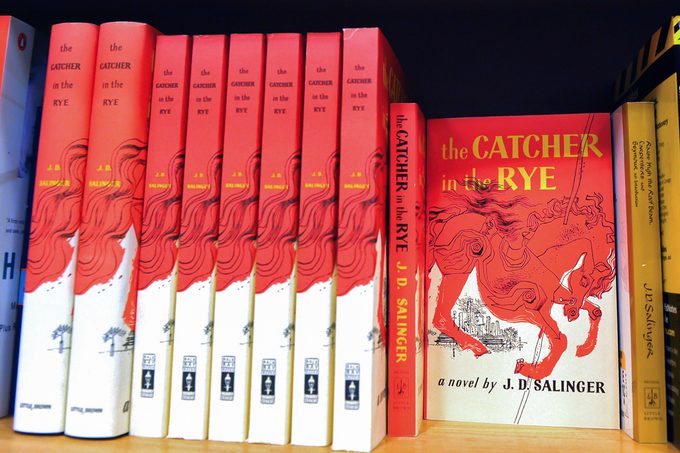Eager to get that hot new novel in paperback format? A bookseller helps us make sense of hardcover versus paperback releases.
Our editors and experts handpick every product we feature. We may earn a commission from your purchases.Learn more.


Eager to get that hot new novel in paperback format? A bookseller helps us make sense of hardcover versus paperback releases.
Our editors and experts handpick every product we feature. We may earn a commission from your purchases.Learn more.
Full disclosure: I get most of my reading done on my Kindle. But when I simply must get my hands on a physical copy of a new book release or time-tested favorite, I prefer paperback. Sure, hardcover books are shiny and solid. They look great on a bookshelf. But I’ve moved too often and travel too frequently to want a heavy, costly book collection. It’s portable, packable paperbacks for me, please. The problem? So many books hit stores in hardback first. And the answer to the big question, “When do paperbacks come out?” isn’t so simple.
I contacted Shannon DeVito, senior director of book strategy and former director of books at Barnes & Noble, to learn why hardcover books come out before paperbacks. She gave me the inside scoop and taught me that, once upon a time, paperback editions weren’t really a thing. (DeVito says Allen Lane, who founded Penguin Books in 1935, was the first to start publishing paperbacks as we know them today.)
Whether you’re shopping for underrated reads or some of the best books of all time, you’ve no doubt run into the paperback-versus-hardcover debate. So let’s take a look at what sets these two formats apart and how publishers determine the timing of hardcover versus paperback releases.
Join the free Reader’s Digest Book Club for great reads, monthly discussions, author Q&As and a community of book lovers.

Simply put, the difference between paperback and hardcover books is the physical book cover. Paperback books have thin, flexible covers that readers can bend or curl. Hardcover books have thick, rigid covers often wrapped in a removable outer cover called a dust jacket.
Paperbacks are cheaper to produce, so they also cost less. The accessible price point means paperbacks tend to be more popular than hardback books. “As a rule of thumb, paperback sales are twice those of hardcover,” says DeVito. “That is, sales break two-thirds to paperback and one-third to hardcover.”
But she says there are three situations in which hardcover book sales exceed or equal those of paperbacks:

In a word: Profit. “In practice, this is about making the most money possible for the author and the publishers, which keeps the wheels of the industry turning,” says DeVito.
Hardcover books tend to be more expensive than paperback books, often retailing for about $30. Limited-edition hardcover books with sprayed edges, artistic endpapers and embossed covers are even more profitable because the set number of copies makes them more desirable to collectors or fans of the author or genre.
Paperbacks not only retail for less but are often steeply discounted by online retailers like Amazon. (Admittedly, you’ll find steeply discounted hardcovers there too; what might cost $30 at Barnes & Noble or your local indie could go for half that.) For example, look no further than the current non-sale retail prices for three classic novels:
“It is the same dynamic in the movie business,” DeVito explains. “The movie shows first in the movie theaters before it lands on the streaming platforms, and even when on the streaming platforms, it will be shown first only via a paid subscription.”
In the United States, paperbacks come out one to two years after the hardcover’s release, according to DeVito. “This is longer than in the U.K., where [books] come out in paperback usually exactly one year later,” she says.
Wondering why the timeline fluctuates so much? To that, we say, “Follow the money.”
If demand is high and a hardcover edition is selling really well, publishers might delay the paperback version to keep those sales going. Take Harry Potter and the Deathly Hallows. The final installment of J.K. Rowling’s fantasy book series hit shelves in hardcover format on July 21, 2007. It wasn’t released in paperback until two years later, July 2009, according to Time magazine.
Of course, there are even wilder timelines, sometimes for reasons only the publisher knows. Eleanor and Park by Rainbow Rowell was released in hardback in 2013, but it didn’t come out in a special paperback version until 2024—that’s 11 years after its initial release!

“Some books sell overwhelmingly only in paperback, so it makes sense to skip the hardcover,” says DeVito. “Equally, some books sell so well in hardcover and only in a small way in paperback, so they never appear in paperback or [do so] only after a very long time.”
Ultimately, the publishing industry must turn a profit to stay afloat—and continue supporting our favorite authors and bringing us new, exciting books. Thus, publishers must crunch the numbers on the profitability of a book before it goes to print.
Not only are paperback books cheaper to print and distribute, but they’re also the format readers are most likely to buy, according to data-gathering company Statista. So unless a publisher is sure it can sell a long run of hardcover copies, it’ll consider taking the book straight to paperback. And if an author’s popularity skyrockets, the publisher may shift formats for the next book.
That’s what happened with bestselling author Emily Henry. Her last two novels, Happy Place and Funny Story, were released in hardback after her previous straight-to-paperback books were wildly successful. And her first novel, 2020’s Beach Read, got a deluxe hardcover glow-up in 2024.
There’s no single answer to, “When do paperbacks come out?” But if you’re wondering how to find out when a book on your TBR list will be released in paperback, we have several suggestions. First, you can check for preorders of a paperback release on the publisher’s website.
You could also check the book listing on your favorite bookseller’s website. Once a publisher has released information about a paperback copy, most booksellers will include a preorder link (along with the exact release date) on the listing. For instance, if you want to check out the Reader’s Digest Book Club selection Daughters of Shandong (and you should!) but prefer paperback, you can look at the release date on Barnes & Noble to learn that the paperback version comes out on May 6, 2025.
Finally, if you’re anxious to get your hands on a paperback release as soon as possible, see if the author posts regularly on social media. Many authors share updates about their book releases on Instagram and TikTok, so follow the hashtags #Bookstagram and #BookTok to get all kinds of bookish content added to your feed.
Get Reader’s Digest’s Read Up newsletter for more books, humor, travel, tech and fun facts all week long.
About the expert
|
At Reader’s Digest, we’ve been sharing our favorite books for over 100 years. We’ve worked with bestselling authors including Susan Orlean, Janet Evanovich and Alex Haley, whose Pulitzer Prize–winning Roots grew out of a project funded by and originally published in the magazine. Through Fiction Favorites (formerly Select Editions and Condensed Books), Reader’s Digest has been publishing anthologies of abridged novels for decades. We’ve worked with some of the biggest names in fiction, including James Patterson, Ruth Ware, Kristin Hannah and more. The Reader’s Digest Book Club, helmed by Books Editor Tracey Neithercott, introduces readers to even more of today’s best fiction by upcoming, bestselling and award-winning authors. For this piece on when paperbacks come out, Leandra Beabout tapped her years of experience as a journalist who covers books for Reader’s Digest to ensure that all information is accurate and offers the best possible advice to readers. We verify all facts and data, back them with credible sourcing and revisit them over time to ensure they remain accurate and up to date. Read more about our team, our contributors and our editorial policies.
Sources: